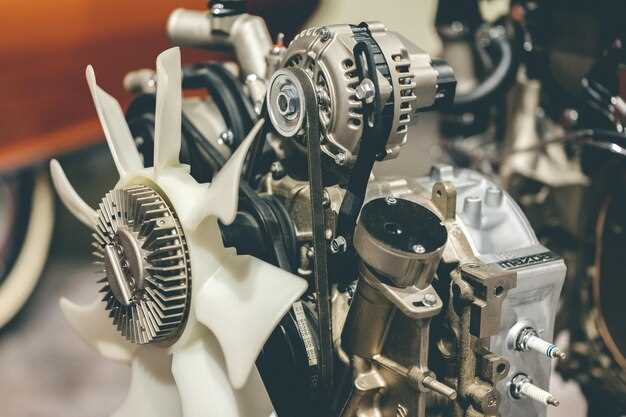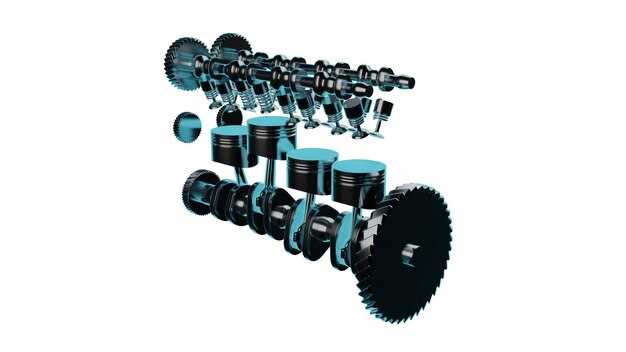How to Rebuild a Transmission for High-Horsepower Applications


The world of high-power vehicles presents unique challenges and opportunities, particularly concerning their transmission systems. As engines output greater torque and horsepower, the need for robust and reliable transmissions becomes paramount. Rebuilding transmissions for these vehicles requires a deep understanding of both the mechanical and performance aspects involved in tailoring a transmission to withstand extreme conditions.
Quality and durability are essential when working with high-power applications. Transmissions in these vehicles not only need to handle increased loads but also offer seamless shifting and responsiveness. This article delves into the critical factors involved in rebuilding transmissions for high-power vehicles, from selecting the right components to understanding the intricacies of gear ratios and shift patterns.
Furthermore, we will explore common modifications and enhancements that can elevate transmission performance, ensuring these high-octane machines deliver their promised power without compromising reliability. Whether you’re a professional builder or an enthusiast, grasping the fundamentals of transmission rebuilding is vital for achieving optimal results.
Understanding the Unique Requirements of High-Power Transmissions
High-power transmissions are critical components in the performance and reliability of vehicles designed to handle increased torque and horsepower. These specialized transmissions must meet specific requirements to ensure they can endure the extreme conditions associated with high-powered applications. One fundamental requirement is the ability to manage significantly higher thermal loads. The increased energy generated in high-power engines translates to more heat, making robust cooling systems and heat-resistant materials essential.
Durability is another key consideration. High-power vehicles often experience elevated stress levels on their transmission components due to the heightened forces during operation. This necessitates the use of advanced materials and reinforced gears that can withstand fatigue and wear over time. For example, utilizing carbon composites or high-grade alloys can significantly enhance the life span and performance of transmission components.
Moreover, the design of high-power transmissions must support rapid gear changes without compromising performance. This requires advanced transmission control systems capable of managing shift timing and torque delivery efficiently. Employing dual-clutch systems or continuously variable transmissions (CVTs) allows for smoother transitions and improved power delivery, which is crucial in competitive settings.
In addition to strength and durability, high-power transmissions must also prioritize reliability under high-stress conditions. This practice includes incorporating rigorous testing protocols to simulate extreme driving scenarios, ensuring that components can operate without failure. Sophisticated diagnostic systems can further enhance reliability by monitoring performance metrics and preemptively identifying potential issues.
Finally, weight reduction is significant in the design of high-power transmissions. Lighter transmissions contribute to better vehicle dynamics and performance, and this can be achieved through strategic engineering and material selection. Advanced manufacturing techniques, such as additive manufacturing, can also play a role in creating lighter, yet equally strong transmission components.
Identifying Common Failures in High-Power Transmissions
High-power transmissions are designed to handle significant torque and horsepower, making them crucial for performance vehicles. However, the demands placed on these systems can lead to common failures. Understanding these issues is essential for effective rebuilding and maintenance.
- Overheating: Excessive heat can cause fluid breakdown, degrading lubrication and leading to component wear or failure. Signs include fluid discoloration and a burnt odor.
- Clutch Slippage: This occurs when the clutch fails to engage fully, resulting in a loss of power transfer. Symptoms may include a high engine RPM without corresponding vehicle acceleration.
- Torque Converter Failure: The torque converter can experience issues such as overheating or internal component failure. Symptoms include shuddering, slipping during acceleration, or unusual noises.
- Gear Misalignment: In high-power settings, gears can become misaligned due to excessive force or inadequate installation. This can lead to increased wear, grinding noises, and eventual failure.
- Fluid Leaks: Leaks can occur from seals, gaskets, or cracks in the transmission housing. Low fluid levels can lead to inadequate lubrication, causing overheating and further damage.
- Synchronized Gear Wear: In manual transmissions, synchronous rings can wear down, leading to difficulty in shifting gears. Symptoms include grinding noises when shifting or inability to engage specific gears.
- Electrical Failures: In modern high-power transmissions, electronic components control shifting. Failures in sensors or control units can result in erratic shifting or complete transmission failure.
Regular inspection and proactive maintenance are critical to identifying and addressing these common failures before they escalate into more severe issues. Understanding these factors aids vehicle owners and mechanics in ensuring the longevity and performance of high-power transmissions.
Choosing the Right Components for Transmission Upgrades
Selecting the right components for transmission upgrades is crucial for maximizing the performance and durability of high-power vehicles. Key elements to consider include the type of gears, clutches, and shift mechanisms, all of which play significant roles in overall efficiency and power handling.
When upgrading gears, opting for high-strength materials such as alloy steel or carbon fiber composites can enhance resilience against wear and stress. Helical gears are often preferred over spur gears due to their ability to handle higher loads and provide smoother operation, reducing noise and vibration in high-performance settings.
Clutch systems are another critical component. Upgrading to multi-plate clutches can improve torque transfer and reduce slip, thus enhancing responsiveness and reducing heat buildup during aggressive driving. It’s essential to choose clutches that match the vehicle’s power output and intended use, such as those specifically designed for drag racing or track performance.
The choice of shift mechanisms, whether manual or automatic, should align with the performance goals of the vehicle. Quick-shift kits or sequential shifters facilitate faster gear changes, allowing drivers to maintain momentum and optimize acceleration. Additionally, electronic control systems can provide customizable shift points and response times, enhancing the driving experience.
Don’t overlook components like bearings and seals, which can significantly impact the longevity of the transmission. Upgrading to high-performance bearings can reduce friction and improve smoothness, while durable seals protect internal components from contamination and fluid loss.
Finally, ensuring compatibility with the vehicle’s engine and intended application is vital. Comprehensive research and professional guidance can help identify suitable parts that not only optimize performance but also maintain reliability under increased stress. By carefully selecting and upgrading transmission components, vehicle enthusiasts can achieve remarkable improvements in power delivery and driving dynamics.
Step-by-Step Guide to Disassembling a High-Power Transmission
Disassembling a high-power transmission requires precision and attention to detail. Follow this guide to ensure a successful teardown.
Prior to starting, gather the necessary tools:
| Tool | Purpose |
|---|---|
| Socket set | For removing bolts |
| Torque wrench | To ensure proper reassembly torque |
| Snap ring pliers | For removing retaining rings |
| Drain pan | To catch fluid |
| Shop rags | For cleaning |
| Magnet | To catch small metal parts |
Follow these steps for disassembly:
- Preparation: Park the vehicle on a flat surface, engage the parking brake, and disconnect the battery.
- Fluid Drainage: Position a drain pan under the transmission. Remove the fluid pan and allow the transmission fluid to fully drain.
- Remove External Components: Detach all external components attached to the transmission. This includes the shifter linkage, electrical connectors, and any sensors.
- Support the Transmission: Use a transmission jack to support the transmission during disassembly. This provides stability and safe handling.
- Unbolt the Transmission: Remove bolts connecting the transmission to the engine. Carefully slide the transmission away from the engine block.
- Inspect the Torque Converter: Remove the torque converter, ensuring you note its orientation before detaching it from the transmission.
- Remove the Bell Housing: Unbolt and remove the bell housing to access internal components.
- Detach Internal Assemblies: Begin to remove parts such as the gear sets and planetary gears. Take note of their arrangement for reassembly.
- Remove Additional Components: Proceed to detach the oil pump, valve body, and any remaining internal elements. Make sure to catalog each part for future reference.
- Complete Disassembly: Once all components are removed, clean the transmission casing thoroughly. Inspect for wear or damage.
Careful documentation and organization of disassembled parts will facilitate efficient reassembly. Always refer to a service manual for specific instructions related to your transmission model.
Testing and Tuning Transmissions for Optimal Performance

Effective testing and tuning of transmissions are essential for achieving the highest possible performance in high-power vehicles. The process begins with a thorough assessment of the transmission’s current state, which includes examining gear ratios, hydraulic pressures, and electronic controls. Using specialized diagnostic tools, technicians can identify any issues that may affect performance, such as slipping gears or improper shifting behavior.
Next, data acquisition during test runs provides critical insights into how the transmission behaves under various driving conditions. This stage typically involves high-speed runs, acceleration tests, and deceleration assessments to gather data on shift points, response times, and torque converter performance. The use of dynometers can enhance this process, allowing for controlled conditions to measure engine and transmission outputs accurately.
Once testing is complete, tuning adjustments can be made to optimize performance. This includes recalibrating electronic control units (ECUs) to modify shift points and pressure settings. Adjustments may also involve fine-tuning the transmission fluid characteristics and ensuring the correct levels are maintained for optimal lubrication and cooling. Additionally, attention must be paid to the alignment and installation of components, as improper setups can lead to inefficiencies and premature wear.
After implementing tuning changes, it’s vital to conduct further testing to validate improvements. Incremental adjustments should be monitored, with comprehensive logging of performance metrics to track changes and identify any areas requiring further refinement. Continuous feedback from both the vehicle’s performance analytics and driver experience plays a key role in achieving the desired outcome.
In summary, systematic testing and tuning of transmissions are crucial for high-power vehicles. This process supports precise control, enhances durability, and ultimately leads to an exhilarating driving experience, showcasing the full potential of the vehicle.
Maintaining and Troubleshooting Rebuilt High-Power Transmissions
High-power transmissions are crucial for the performance and reliability of modified vehicles. Proper maintenance and troubleshooting techniques will extend the life of a rebuilt transmission and ensure optimal operation.
Regular Maintenance
Routine maintenance is essential for high-power transmissions. Regular fluid changes should be performed, as transmission fluid degrades over time and can lose its ability to lubricate and cool the system effectively. Always use the manufacturer-recommended fluids to ensure compatibility and performance.
Inspect and replace transmission filters periodically. Clogged filters can lead to poor fluid circulation, resulting in increased wear and potential failure of internal components.
Keep an eye on fluid levels and quality. Any signs of burning smell or discoloration can indicate overheating or contamination. Addressing these issues early can prevent more severe damage.
Troubleshooting Common Issues
When encountering problems with a rebuilt transmission, identifying the symptoms is the first step. Common issues include slipping gears, unusual noises, and erratic shifting. Each symptom has its own potential causes.
If the transmission slips or fails to engage, low fluid levels could be the culprit. Check for leaks in seals and gaskets, as fluid loss can lead to inadequate pressure for proper engagement.
Unusual noises, such as grinding or whining, may point to problems with internal components or bearings. In such cases, immediate inspection is necessary to prevent further damage.
Erratic shifting might indicate an issue with the transmission control module or the linkage. A diagnostic scan can pinpoint electronic issues that may be affecting performance.
Expert Consultation
If troubleshooting does not resolve the issue, consulting a transmission specialist is recommended. They can conduct in-depth diagnostics and repairs that may not be feasible for an average vehicle owner.
In conclusion, maintaining and troubleshooting rebuilt high-power transmissions involves regular inspections, fluid management, and prompt attention to issues as they arise. By following these guidelines, vehicle owners can enhance the longevity and reliability of their high-performance transmissions.
